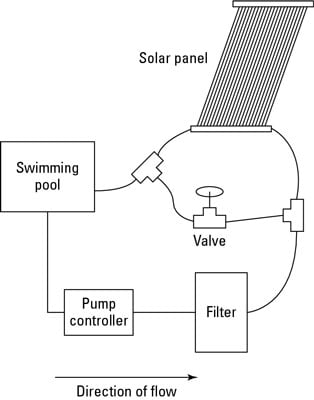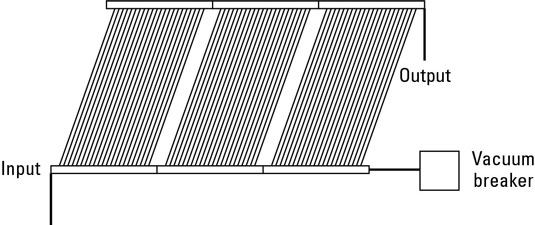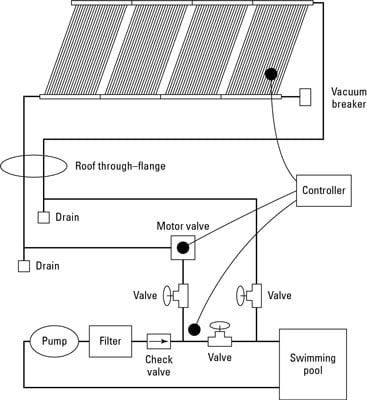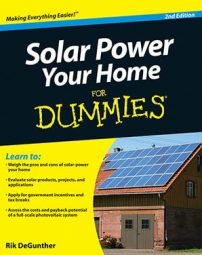You can heat your pool using solar power. Your pool system already includes the pump, controller, and filter, along with PVC pipes that route the water flow. Simply break into the PVC line after the filter and run a couple of flex hoses (or PVC, if you prefer) to the solar collector panel, which you can lay out on the ground or set against a hill to achieve some tilt toward the sun.

When the valve is closed, water runs exclusively through the solar collector panel, heating the water. As you open the valve, less water flows through the collector panel. In this way, you can adjust how much heat is going into your pool.
Solar collector panels are available at most pool supply stores. Adaptors are sometimes necessary.
Here are some ways to run the system for best results:
Place the solar collector panel where it sees the most sunlight when the pool pump is running.
If you place the solar collector panel on your roof, try to minimize resistance to the water flow.
Keep the solar panel out of the wind as much as possible.
For best heating results, run the pool pump during the sunniest time of the day; running it longer will result in more heat in the pool.
If you want to use two or more solar collector panels, connect them in parallel.
 Flexible solar collector panels that are designed to fit together in a parallel ganged arrangement reduce the overall water pressure while heating the same amount of water.
Flexible solar collector panels that are designed to fit together in a parallel ganged arrangement reduce the overall water pressure while heating the same amount of water.
The general rule is to use a total collector surface area that's about half the surface area of your pool. But this varies quite a bit. Sizing your collector surface area depends on a number of factors:
The pump's running time: The longer it's on, the more heat you collect in the pool for a given collector size.
Pool location: If you have an above ground pool, the heat loss is much greater. You need a collector with more surface area.
Solar potential when the pump is on: Note how your solar panels are oriented. How much sunlight do you get?
Shade: Cutting down Old Man Oak isn't much of an option if your blood is truly green. Otherwise, choose a larger collector.
Wind: If you have a lot of wind, your collectors will run inefficiently unless they are glazed.
Swimming pools cost a lot. If you don't have any kind of swimming pool heater, your useable season may be around four months of the year. If you install a swimming pool heating system, you can get eight months. This explains the popularity of pool heaters.
In a full-scale, professional-grade swimming pool solar system, when the pump is on, the controller decides whether to activate the solar collectors by measuring the temperature at the collectors and the temperature of the pool water. When heat's available at the collector, the motor valve opens, and the pump moves water up into the collectors and back down to the swimming pool.


